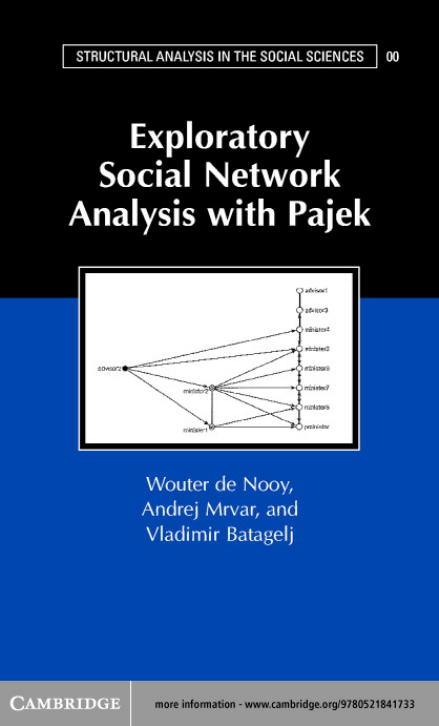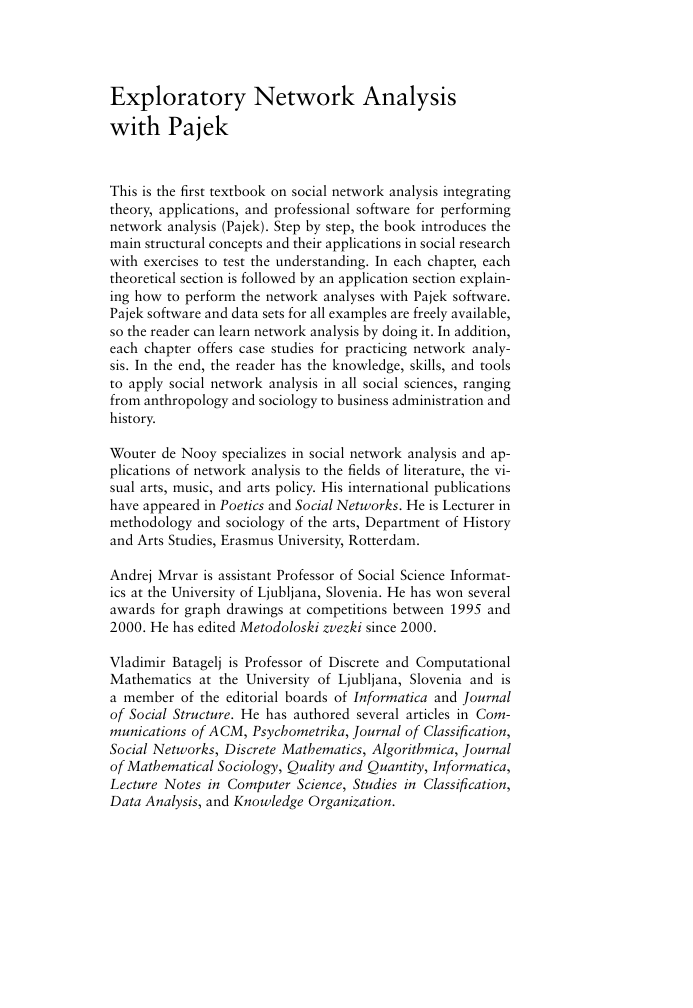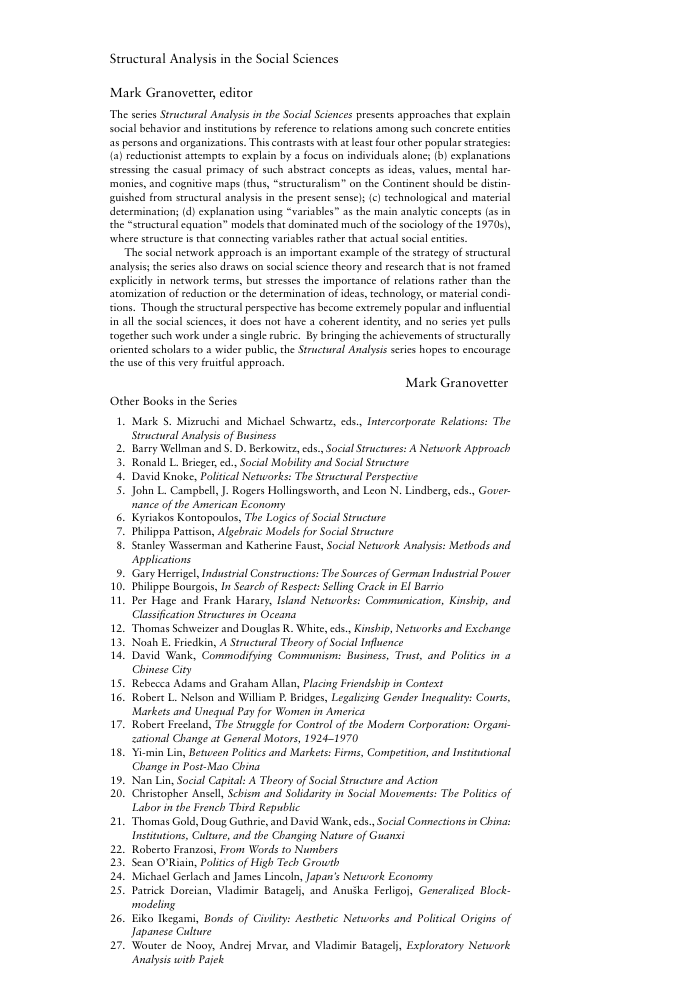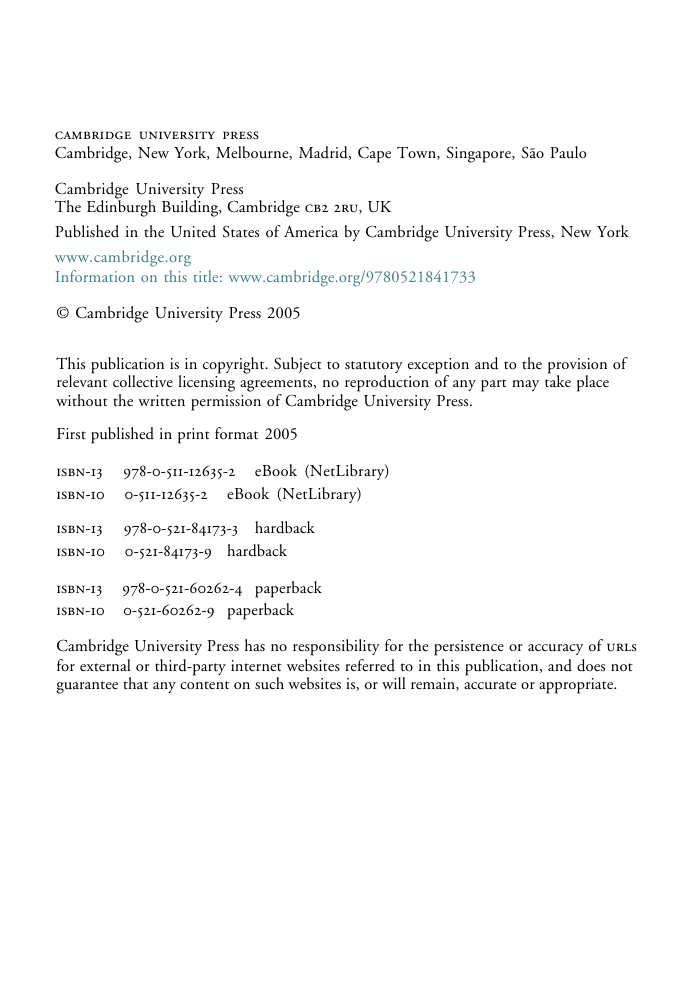�
This page intentionally left blank
Exploratory Network Analysis
with Pajek
This is the first textbook on social network analysis integrating
theory, applications, and professional software for performing
network analysis (Pajek). Step by step, the book introduces the
main structural concepts and their applications in social research
with exercises to test the understanding. In each chapter, each
theoretical section is followed by an application section explain-
ing how to perform the network analyses with Pajek software.
Pajek software and data sets for all examples are freely available,
so the reader can learn network analysis by doing it. In addition,
each chapter offers case studies for practicing network analy-
sis. In the end, the reader has the knowledge, skills, and tools
to apply social network analysis in all social sciences, ranging
from anthropology and sociology to business administration and
history.
Wouter de Nooy specializes in social network analysis and ap-
plications of network analysis to the fields of literature, the vi-
sual arts, music, and arts policy. His international publications
have appeared in Poetics and Social Networks. He is Lecturer in
methodology and sociology of the arts, Department of History
and Arts Studies, Erasmus University, Rotterdam.
Andrej Mrvar is assistant Professor of Social Science Informat-
ics at the University of Ljubljana, Slovenia. He has won several
awards for graph drawings at competitions between 1995 and
2000. He has edited Metodoloski zvezki since 2000.
Vladimir Batagelj is Professor of Discrete and Computational
Mathematics at the University of Ljubljana, Slovenia and is
a member of the editorial boards of Informatica and Journal
of Social Structure. He has authored several articles in Com-
munications of ACM, Psychometrika, Journal of Classification,
Social Networks, Discrete Mathematics, Algorithmica, Journal
of Mathematical Sociology, Quality and Quantity, Informatica,
Lecture Notes in Computer Science, Studies in Classification,
Data Analysis, and Knowledge Organization.
�
Structural Analysis in the Social Sciences
Mark Granovetter, editor
The series Structural Analysis in the Social Sciences presents approaches that explain
social behavior and institutions by reference to relations among such concrete entities
as persons and organizations. This contrasts with at least four other popular strategies:
(a) reductionist attempts to explain by a focus on individuals alone; (b) explanations
stressing the casual primacy of such abstract concepts as ideas, values, mental har-
monies, and cognitive maps (thus, “structuralism” on the Continent should be distin-
guished from structural analysis in the present sense); (c) technological and material
determination; (d) explanation using “variables” as the main analytic concepts (as in
the “structural equation” models that dominated much of the sociology of the 1970s),
where structure is that connecting variables rather that actual social entities.
The social network approach is an important example of the strategy of structural
analysis; the series also draws on social science theory and research that is not framed
explicitly in network terms, but stresses the importance of relations rather than the
atomization of reduction or the determination of ideas, technology, or material condi-
tions. Though the structural perspective has become extremely popular and influential
in all the social sciences, it does not have a coherent identity, and no series yet pulls
together such work under a single rubric. By bringing the achievements of structurally
oriented scholars to a wider public, the Structural Analysis series hopes to encourage
the use of this very fruitful approach.
Mark Granovetter
Other Books in the Series
1. Mark S. Mizruchi and Michael Schwartz, eds., Intercorporate Relations: The
Structural Analysis of Business
2. Barry Wellman and S. D. Berkowitz, eds., Social Structures: A Network Approach
3. Ronald L. Brieger, ed., Social Mobility and Social Structure
4. David Knoke, Political Networks: The Structural Perspective
5. John L. Campbell, J. Rogers Hollingsworth, and Leon N. Lindberg, eds., Gover-
nance of the American Economy
6. Kyriakos Kontopoulos, The Logics of Social Structure
7. Philippa Pattison, Algebraic Models for Social Structure
8. Stanley Wasserman and Katherine Faust, Social Network Analysis: Methods and
Applications
9. Gary Herrigel, Industrial Constructions: The Sources of German Industrial Power
10. Philippe Bourgois, In Search of Respect: Selling Crack in El Barrio
11. Per Hage and Frank Harary, Island Networks: Communication, Kinship, and
Classification Structures in Oceana
12. Thomas Schweizer and Douglas R. White, eds., Kinship, Networks and Exchange
13. Noah E. Friedkin, A Structural Theory of Social Influence
14. David Wank, Commodifying Communism: Business, Trust, and Politics in a
Chinese City
15. Rebecca Adams and Graham Allan, Placing Friendship in Context
16. Robert L. Nelson and William P. Bridges, Legalizing Gender Inequality: Courts,
Markets and Unequal Pay for Women in America
17. Robert Freeland, The Struggle for Control of the Modern Corporation: Organi-
zational Change at General Motors, 1924–1970
18. Yi-min Lin, Between Politics and Markets: Firms, Competition, and Institutional
Change in Post-Mao China
19. Nan Lin, Social Capital: A Theory of Social Structure and Action
20. Christopher Ansell, Schism and Solidarity in Social Movements: The Politics of
Labor in the French Third Republic
21. Thomas Gold, Doug Guthrie, and David Wank, eds., Social Connections in China:
Institutions, Culture, and the Changing Nature of Guanxi
22. Roberto Franzosi, From Words to Numbers
23. Sean O’Riain, Politics of High Tech Growth
24. Michael Gerlach and James Lincoln, Japan’s Network Economy
25. Patrick Doreian, Vladimir Batagelj, and Anuˇska Ferligoj, Generalized Block-
modeling
26. Eiko Ikegami, Bonds of Civility: Aesthetic Networks and Political Origins of
Japanese Culture
27. Wouter de Nooy, Andrej Mrvar, and Vladimir Batagelj, Exploratory Network
Analysis with Pajek
�
Exploratory Network
Analysis with Pajek
WOUTER DE NOOY
Erasmus University Rotterdam
ANDREJ MRVAR
University of Ljubljana
VLADIMIR BATAGELJ
University of Ljubljana
�
Cambridge, New York, Melbourne, Madrid, Cape Town, Singapore, São Paulo
Cambridge University Press
The Edinburgh Building, Cambridge , UK
Published in the United States of America by Cambridge University Press, New York
www.cambridge.org
Information on this title: www.cambridg e.org /9780521841733
© Cambridge University Press 2005
This publication is in copyright. Subject to statutory exception and to the provision of
relevant collective licensing agreements, no reproduction of any part may take place
without the written permission of Cambridge University Press.
First published in print format
2005
-
-
-
-
-
-
----
---
eBook (NetLibrary)
eBook (NetLibrary)
----
---
hardback
hardback
----
---
paperback
paperback
Cambridge University Press has no responsibility for the persistence or accuracy of s
for external or third-party internet websites referred to in this publication, and does not
guarantee that any content on such websites is, or will remain, accurate or appropriate.
�
To Anuˇska,
who makes things happen
�
�
















 2023年江西萍乡中考道德与法治真题及答案.doc
2023年江西萍乡中考道德与法治真题及答案.doc 2012年重庆南川中考生物真题及答案.doc
2012年重庆南川中考生物真题及答案.doc 2013年江西师范大学地理学综合及文艺理论基础考研真题.doc
2013年江西师范大学地理学综合及文艺理论基础考研真题.doc 2020年四川甘孜小升初语文真题及答案I卷.doc
2020年四川甘孜小升初语文真题及答案I卷.doc 2020年注册岩土工程师专业基础考试真题及答案.doc
2020年注册岩土工程师专业基础考试真题及答案.doc 2023-2024学年福建省厦门市九年级上学期数学月考试题及答案.doc
2023-2024学年福建省厦门市九年级上学期数学月考试题及答案.doc 2021-2022学年辽宁省沈阳市大东区九年级上学期语文期末试题及答案.doc
2021-2022学年辽宁省沈阳市大东区九年级上学期语文期末试题及答案.doc 2022-2023学年北京东城区初三第一学期物理期末试卷及答案.doc
2022-2023学年北京东城区初三第一学期物理期末试卷及答案.doc 2018上半年江西教师资格初中地理学科知识与教学能力真题及答案.doc
2018上半年江西教师资格初中地理学科知识与教学能力真题及答案.doc 2012年河北国家公务员申论考试真题及答案-省级.doc
2012年河北国家公务员申论考试真题及答案-省级.doc 2020-2021学年江苏省扬州市江都区邵樊片九年级上学期数学第一次质量检测试题及答案.doc
2020-2021学年江苏省扬州市江都区邵樊片九年级上学期数学第一次质量检测试题及答案.doc 2022下半年黑龙江教师资格证中学综合素质真题及答案.doc
2022下半年黑龙江教师资格证中学综合素质真题及答案.doc